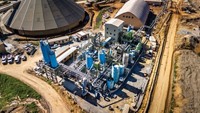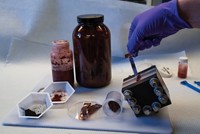Advertisement
Grab your lab coat. Let's get started
Welcome!
Welcome!
Create an account below to get 6 C&EN articles per month, receive newsletters and more - all free.
It seems this is your first time logging in online. Please enter the following information to continue.
As an ACS member you automatically get access to this site. All we need is few more details to create your reading experience.
Not you? Sign in with a different account.
Not you? Sign in with a different account.
ERROR 1
ERROR 1
ERROR 2
ERROR 2
ERROR 2
ERROR 2
ERROR 2
Password and Confirm password must match.
If you have an ACS member number, please enter it here so we can link this account to your membership. (optional)
ERROR 2
ACS values your privacy. By submitting your information, you are gaining access to C&EN and subscribing to our weekly newsletter. We use the information you provide to make your reading experience better, and we will never sell your data to third party members.
Recycling
Could cement and steel team up to cut emissions?
Cement can be recycled by throwing it into electric steel-recycling furnaces
by Prachi Patel
May 28, 2024

The production of cement and steel creates roughly 13% of the world’s anthropogenic carbon dioxide emissions. Combining the recycling of the two ubiquitous building materials could cut those emissions, researchers say (Nature 2024, DOI: 10.1038/s41586-024-07338-8). They show that adding waste cement into the electric arc furnaces (EAFs) used to recycle steel produces a material that can be recycled into new cement.
Cement holds together the gravel and sand in concrete. Producing both cement and steel involves high temperatures—typically generated by burning fossil fuels—and chemical reactions that release CO2. Cement is made by mixing calcium carbonate with clays and heating in a kiln to form calcium silicates, called clinker, a precursor of cement. The process converts calcium carbonate to calcium oxide—or lime—releasing CO2. Producing steel, meanwhile, involves smelting iron oxide ore and carbon in a blast furnace.
Decarbonizing cement and steel is a formidable challenge. Both industries are exploring the use of alternative fuels, low-carbon substitutes for cement, and electric processes. Some companies, for instance, make and recycle steel in EAFs.
Recycling materials also reduces emissions. While steel is the most recycled material by weight in the world, cement is not recycled. Researchers have looked into heating waste cement obtained from crushed concrete in a kiln to make new clinker, but doing this in practice has been challenging.
Cyrille Dunant, Julian M. Allwood, and colleagues at the University of Cambridge decided to heat waste cement in an EAF—specifically, an EAF used to recycle steel. Steel recycling requires the addition of lime, whose job is to bind with impurities and metal- and silicon-based oxides to form a removable by-product called slag.
The researchers replaced some of the lime with waste cement, which they found performed the same job as the lime. But now, instead of a low-quality slag in the end, they got a product that has a composition nearly identical to pristine clinker. The material needs to be adjusted by adding small amounts of lime, alumina, and silica, but then the slag can be dried, crushed, and used to make new cement.
The process reduces the emissions of both cement and steel by replacing CO2-intensive lime and recycling materials that would otherwise become waste. Zero-emission cement is possible if the EAF were powered by renewable energy. “This is proof that cement is a recyclable material the same way steel and aluminum are and that it’s possible to recycle cement in an electrical process,” Dunant says.
EAFs today make up a small fraction of global steelmaking. Plus, cement demand will grow mainly in countries with little steel production, says Karen Scrivener, a material chemist at the Swiss Federal Institute of Technology, Lausanne (EPFL). “I do not think this product will have significant impact in a global context,” she says.
Nonetheless, “this is an important piece of work,” says Sabbie Miller, a civil and environmental engineer at the University of California, Davis, adding that the process will be most effective when used with other cement decarbonization strategies. “Implementing a suite of effective strategies that are appropriate for a region or application as fast as possible will help us more quickly reach our emissions targets. I think this technology could be part of that suite for some places.”
The Cambridge team plans to start industrial-level trials soon through its spin-off called Cambridge Electric Cement. The trials will produce 40 metric tons of recycled cement an hour in a commercial EAF owned and operated by Celsa Steel UK, the largest steel recycling company in the UK.





Join the conversation
Contact the reporter
Submit a Letter to the Editor for publication
Engage with us on Twitter